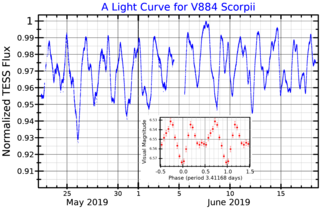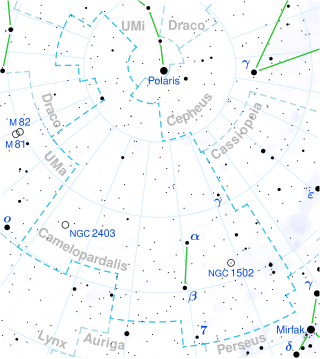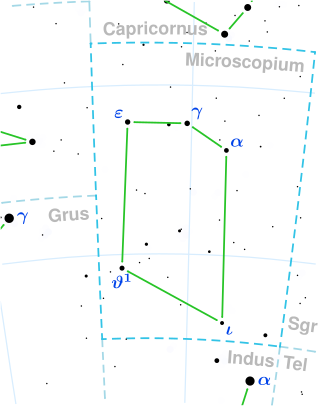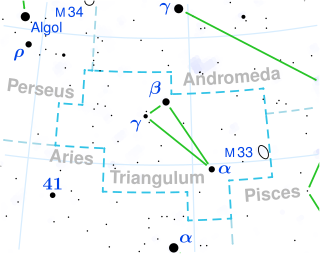Related Research Articles
HD 63454, formally named Ceibo, is a star located in the southern circumpolar constellation Chamaeleon near the border with Mensa To see the star, one needs a small telescope because it has an apparent magnitude of 9.36, which is below the limit for naked eye visibility. The object is located relatively close at a distance of 123 light years based on Gaia DR3 parallax measurements but is receding with a heliocentric radial velocity of 33.8 km/s. At its current distance, HD 63454's brightness is diminished by two tenths of a magnitude due to interstellar dust. It has an absolute magnitude of +6.68.

4U 1700-37 is one of the stronger binary X-ray sources in the sky, and is classified as a high-mass X-ray binary. It was discovered by the Uhuru satellite. The "4U" designation refers to the fourth Uhuru catalog.

HD 24479, also designated as HR 1204, is a solitary, bluish-white hued star located in the northern circumpolar constellation Camelopardalis. The star is visible to the naked eye with an apparent visual magnitude of 5.04. Based on Gaia DR3 parallax measurements, it is located 385 light years from the Sun. However, it is receding with a somewhat constrained heliocentric radial velocity of 4.6 km/s. At its current distance, HD 24479's brightness is diminished by 0.29 magnitudes due to interstellar dust.

2 Piscis Austrini, also known as HD 200763 or simply 2 PsA, is a solitary orange hued star located in the southern constellation Microscopium. It was once part of Piscis Austrinus, the southern fish. The object has an apparent magnitude of 5.2, making it faintly visible to the naked eye under ideal conditions. Based on parallax measurements from the Gaia satellite, it is estimated to be 354 light years away from the Solar System. However, it is receding with a poorly constrained heliocentric radial velocity of 3.1 km/s. At its current distance, 2 PsA's brightness is diminished by 0.11 magnitudes due to interstellar dust. It has an absolute magnitude of 0.19.

S Apodis, also known as HD 133444 is a variable star located in the southern circumpolar constellation Apus. It has an apparent magnitude ranging from 9.6 to 17, which is below the limit for naked eye visibility. The object is located relatively far at a distance of approximately 15,000 light years based on Gaia DR3 parallax measurements, but it is drifting closer with a heliocentric radial velocity of −75 km/s.

NGC 708 is an elliptical galaxy located 240 million light-years away in the constellation Andromeda and was discovered by astronomer William Herschel on September 21, 1786. It is classified as a cD galaxy and is the brightest member of Abell 262. NGC 708 is a weak FR I radio galaxy and is also classified as a type 2 Seyfert galaxy.

HD 26764, also known as HR 1314 or rarely 14 H. Camelopardalis, is a solitary white hued star located in the northern circumpolar constellation Camelopardalis. It has an apparent magnitude of 5.19, making it faintly to the naked eye if viewed under good conditions. Gaia DR3 parallax measurements place the object at a distance of 266 light years and is drifting closer with a poorly constrained heliocentric radial velocity of 3 km/s. At its current distance, HD 26764's brightness is diminished by 0.26 magnitudes due to interstellar dust.

HD 193307 is the primary of a binary star located the southern constellation Telescopium. It has an apparent magnitude of 6.27, placing it near the limit for naked eye visibility, even under ideal conditions. The star is located relatively close at a distance of 102 light years based on Gaia DR3 parallax measurements, but it is receding with a heliocentric radial velocity of 16.9 km/s. At its current distance, HD 193307's brightness is diminished by 0.18 magnitudes due to extinction from interstellar dust and it has an absolute magnitude of +3.80. HD 193307 has a relatively high proper motion, moving at a rate of 437 mas/yr.

HD 27022, also known as HR 1327, is a star located in the northern circumpolar constellation Camelopardalis. The object has also been designated as 20 H. Camelopardalis, but is not commonly used in modern times. It has an apparent magnitude of 5.27, allowing it to be faintly visible to the naked eye. Based on parallax measurements from Gaia DR3, the star has been estimated to be 347 light years away. It appears to be approaching the Solar System, having a heliocentric radial velocity of −19.5 km/s.

HD 76236, also designated as HR 3543 or rarely 11 G. Chamaeleontis, is a solitary star located in the southern circumpolar constellation Chamaeleon. It is faintly visible to the naked eye as an orange-hued star with an apparent magnitude of 5.77. Based on parallax measurements from the Gaia satellite, the object is estimated to be 612 light years away. Currently, it is receding with a heliocentric radial velocity of 7 km/s. At its current distance, HD 76236's brightness is diminished by 0.39 magnitudes due to interstellar dust. It has an absolute magnitude of −0.13.
HD 64307, also known as HR 3075, is a solitary, orange hued star located in the northern circumpolar constellation Camelopardalis. It has an apparent magnitude of 5.35, allowing it to be faintly seen with the naked eye. Based on parallax measurements from the Gaia spacecraft, The object is estimated to be 690 light years distant. It appears to be receding from the Sun, having a heliocentric radial velocity of 34 km/s.

14 Trianguli, also known as HD 15656, is a spectroscopic binary located in the northern constellation Triangulum. It has an apparent magnitude of 5.14, making it faintly visible to the naked eye in ideal conditions. Gaia DR3 parallax measurements place the system 433 light years away, and it is currently approaching the Solar System with a heliocentric radial velocity of −37 km/s. At its current distance, 14 Tri's brightness is diminished by 0.21 magnitude due to interstellar dust. It has an absolute magnitude of −0.46.
10 Delphini is a solitary star in the equatorial constellation Delphinus. It has an apparent magnitude of 6.00, allowing it to be faintly seen with the naked eye. Parallax measurements put the object at a distance of 493 light years but is drifting closer with a heliocentric radial velocity of −32 km/s.
HD 37289, also known as HR 1916, is a solitary, orange hued star located in the northern circumpolar constellation Camelopardalis. It has an apparent magnitude of 5.61, making it faintly visible to the naked eye under ideal conditions. Based on parallax measurements from the Gaia spacecraft, the object is estimated to be 308 light years distant. It appears to be approaching the Sun, having a heliocentric radial velocity of −20.7 km/s.
HD 58425, also known as HR 2830, is an astrometric binary located in the northern circumpolar constellation Camelopardalis. It is faintly visible to the naked eye as an orang point of light at an apparent magnitude of 5.64. Based on parallax measurements from Gaia DR3, the system is estimated to be 470 light years away from Earth. It appears to be rapidly receding from the Sun, having a heliocentric radial velocity of 58.6 km/s. HD 58425 is listed as 54 Ursae Majoris in Johann Hevelius' catalogue, but this was dropped after the official IAU's official constellation borders were drawn.

NGC 1570, mistakenly called NGC 1571, is a faint galaxy located in the southern constellation Caelum, the chisel. It has a blue magnitude of 13.2, making it visible through a medium sized telescope. Based on a redshift of z = 0.014760, the object is estimated to be 198 million light years away from the Local Group. It appears to be receding with a heliocentric radial velocity of 4,392 km/s.

HD 36187, also known as HR 1835, is a solitary, bluish-white hued star located in the southern constellation Columba, the dove. It has an apparent magnitude of 5.55, making it faintly visible to the naked eye under ideal conditions. Based on parallax measurements from the Gaia spacecraft, it is estimated to be 282 light years away from the Solar System. However, it is receding rapidly with a heliocentric radial velocity of 50 km/s. At its current distance, HD 36187's brightness is diminished by 0.21 magnitude due to interstellar dust.

HD 117566, also known as HR 5091, is a solitary yellow-hued star located in the northern circumpolar constellation Camelopardalis. It has an apparent magnitude of 5.74, making it faintly visible to the naked eye. This object is relatively close at a distance of 291 light years based on Gaia DR3 parallax measurements but is receding with a heliocentric radial velocity of 14 km/s. At its current distance, HD 117566's brightness is diminished by 0.12 magnitudes due to interstellar dust.

V701 Coronae Australis, or simply V701 CrA, is a solitary, yellowish-white hued variable star located in the southern constellation Corona Australis. It has an average apparent magnitude of 5.72, making it faintly visible to the naked eye under ideal conditions. The object is located relatively close at a distance of 213 light-years based on Gaia DR3 parallax measurements, and it is currently receding with a poorly constrained heliocentric radial velocity of 4 km/s. At its current distance, V701 CrA's brightness is diminished by a quarter of a magnitude due to extinction and it has an absolute magnitude of +1.55.

HD 27322, also known as HR 1342, is a binary star located in the northern circumpolar constellation Camelopardalis. The visible component is faintly visible to the naked eye as a white-hued point of light with an apparent magnitude of 5.92. The object is located relatively close at a distance of 313 light-years based on Gaia DR3 parallax measurements, and it is drifting closer with a heliocentric radial velocity of approximately −13 km/s. At its current distance, HD 27322's brightness is diminished by 0.24 magnitudes due to interstellar extinction and it has an absolute magnitude of +0.98.
References
- 1 2 3 4 5 Vallenari, A.; et al. (Gaia collaboration) (2023). "Gaia Data Release 3. Summary of the content and survey properties". Astronomy and Astrophysics. 674: A1. arXiv: 2208.00211 . Bibcode:2023A&A...674A...1G. doi:10.1051/0004-6361/202243940. S2CID 244398875. Gaia DR3 record for this source at VizieR.
- ↑ Alfonso-Garzón, J.; Domingo, A.; Mas-Hesse, J. M.; Giménez, A. (26 November 2012). "The first INTEGRAL-OMC catalogue of optically variable sources". Astronomy & Astrophysics. 548: A79. arXiv: 1210.0821 . Bibcode:2012A&A...548A..79A. doi: 10.1051/0004-6361/201220095 . eISSN 1432-0746. ISSN 0004-6361. S2CID 118428054.
- 1 2 Samus’, N. N.; Kazarovets, E. V.; Durlevich, O. V.; Kireeva, N. N.; Pastukhova, E. N. (January 2017). "General catalogue of variable stars: Version GCVS 5.1". Astronomy Reports. 61 (1): 80–88. Bibcode:2017ARep...61...80S. doi:10.1134/S1063772917010085. eISSN 1562-6881. ISSN 1063-7729. S2CID 125853869.
- ↑ Kolb, U. (21 June 1998). "Soft X-ray transients in the Hertzsprung gap". Monthly Notices of the Royal Astronomical Society. 297 (2): 419–426. arXiv: astro-ph/9801283 . Bibcode:1998MNRAS.297..419K. doi: 10.1046/j.1365-8711.1998.01489.x . eISSN 1365-2966. ISSN 0035-8711. S2CID 18862109.
- 1 2 3 4 Orosz, Jerome A.; Jain, Raj K.; Bailyn, Charles D.; McClintock, Jeffrey E.; Remillard, Ronald A. (20 May 1998). "Orbital Parameters for the Soft X‐Ray Transient 4U 1543−47: Evidence for a Black Hole". The Astrophysical Journal. 499 (1): 375–384. arXiv: astro-ph/9712018 . Bibcode:1998ApJ...499..375O. doi: 10.1086/305620 . eISSN 1538-4357. ISSN 0004-637X. S2CID 16991861.
- ↑ Ritter, H.; Kolb, U. (26 May 2003). "Catalogue of cataclysmic binaries, low–mass X-ray binaries and related objects (Seventh edition)". Astronomy & Astrophysics. 404 (1): 301–303. arXiv: astro-ph/0301444 . Bibcode:2003A&A...404..301R. doi: 10.1051/0004-6361:20030330 . eISSN 1432-0746. ISSN 0004-6361. S2CID 61117701.
- ↑ Stassun, Keivan G.; et al. (9 September 2019). "The Revised TESS Input Catalog and Candidate Target List". The Astronomical Journal. 158 (4): 138. arXiv: 1905.10694 . Bibcode:2019AJ....158..138S. doi: 10.3847/1538-3881/ab3467 . eISSN 1538-3881. hdl: 1721.1/124721 . S2CID 166227927.
- ↑ Anders, F.; et al. (February 2022). "Photo-astrometric distances, extinctions, and astrophysical parameters for Gaia EDR3 stars brighter than G = 18.5". Astronomy & Astrophysics. 658: A91. arXiv: 2111.01860 . Bibcode:2022A&A...658A..91A. doi: 10.1051/0004-6361/202142369 . eISSN 1432-0746. ISSN 0004-6361.
- ↑ Özel, Feryal; Psaltis, Dimitrios; Narayan, Ramesh; McClintock, Jeffrey E. (2 December 2010). "The Black Hole Mass Distribution in the Galaxy". The Astrophysical Journal. 725 (2): 1918–1927. arXiv: 1006.2834 . Bibcode:2010ApJ...725.1918O. doi: 10.1088/0004-637X/725/2/1918 . eISSN 1538-4357. ISSN 0004-637X. S2CID 46933635.
- ↑ "V* IL Lup". SIMBAD . Centre de données astronomiques de Strasbourg . Retrieved April 13, 2023.
- ↑ Palombara, Nicola La; Mereghetti, Sandro (2 February 2008). "XMM-Newton observation of 4U 1543–475: The X-ray spectrum of a stellar-mass black-hole at low luminosity". Astronomy & Astrophysics . 430 (2005): L53–L56. arXiv: astro-ph/0412209 . Bibcode:2005A&A...430L..53L. CiteSeerX 10.1.1.316.7094 . doi:10.1051/0004-6361:200400123. S2CID 865125.
- ↑ MATiLSKY, T. A.; Giacconi, R.; Gursky, H.; Kellogg, E. M.; Tananbaum, H. D. (15 May 1972). "A New Transient Source Observed by UHURU". The Astrophysical Journal . 174: L53–L55. Bibcode:1972ApJ...174L..53M. doi: 10.1086/180947 .
- ↑ Kitamoto, S.; Miyamoto, S.; Tsunemi, H; Makishima, K; Nakagawa, M (1 June 1984). "The transient X-ray source 4U 1543-47 observed from TENMA". Publications of the Astronomical Society of Japan. 36 (4): 799–806. Bibcode:1984PASJ...36..799K.